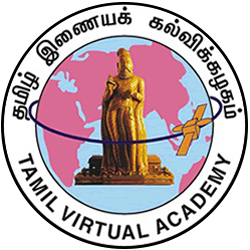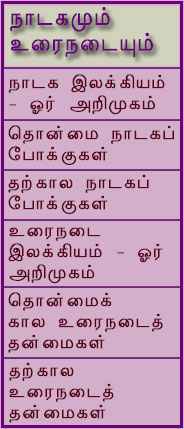Primary tabs
-
LESSON - 2
p20342 Trends in Ancient Drama
This lesson throws light on the trends in ancient Tamil
drama. It traces the evolution of Tamil drama and discusses
some of the popular forms of Tamil drama. The origin of
Tamil drama is closely associated with rituals. Sangam
literature has several references to various forms of ‘koothu’
such as ‘thunangai’, ‘veri’, ‘thudi’ and ‘kuravai’ which were
enacted during religious festivals. In the post sangam period
drama flourished under the patronage of Kings. Plays enacted
during this period extolled the glory of Kings. Until the 16th
century Tamil drama was either based on religion or kings. As
these plays were not written down we know very little about
them today. The 16th, 17th and 18th centuries are regarded as
the most significant periods in the history of Tamil drama.
Drama which was hitherto confined to the temples and royal
courts reached the public spaces. Various forms of drama
such as ‘pallu’, kuravanji’, ‘nondi nadagam’, ‘kuluvam’, maguda
nadagam’ and ‘keerthanai’ evolved during this period.
‘Pallu’ was a form of drama popular in the 16th century. It
was pastoral in theme and revolved around the lives of
ordinary farmers and tillers. They were simple in form and
easy to enact. The ‘pallu’ marked a major change in dramatic
trends. Gods and kings were no longer the only subject of
drama. Drama became more and more people centric.
‘Thiruvaaroor Pallu’, ‘Kathirai Malai Pallu’ and ‘Mukkoodar Pallu’
are some renowned pallus of this period.
‘Kuravanji’ was another important form of ancient Tamil
drama. Also called ‘kurathi paatu’ and kuram’, the kuravanji
plays portrayed the lives of the ‘kuravar’ who were the hill
people. The fortune telling kurathi, a woman of the kurava hill
folk, was the protagonist of kuravanji plays. ‘Kumbesar
Kuravanji Nadagam’ and ‘Sarabendra Boopala Kuravanji
Nadagam’ are 2 famous kuravanjis.
‘Nondi Nadagam’ which originated in the 17th century is
also known as ‘Ottraikkal Nadagam’. The protagonist of this
drama was a lame man and hence the name ‘nondi ndagam’,
‘nondi’ meaning ‘lame’. Usually enacted by one man, the nondi
nadagam depicted the transformation of the protagonist from
a wicked, sinful man into a repentant, virtuous being. Didactic
in nature, the nondi nadagam aimed at reforming people
through humour. ‘Thiruchendur Nondi Nadagam’ and
‘Seethakathi Nondi Nadagam’ are 2 popular plays in this
genre.
‘Vilasa Nadagam’ which bore resemblance to several literary
forms was a form of drama that belonged to the minor
literature (or sittrilakkiyam). ‘Keerthanaigal’ which flourished
during the late 18th and the early 19th centuries were a form
of musical plays that were based on epics or bhakti literature.
‘Rama Nadaga Keerthanai’ written by Seerkaazhi Arunachala
Kavirayar in 1771 is considered to be the forerunner in this
genre. ‘Manonmaniyam’ written in 1891 by Professor Sundaram
Pillai ushered in a new era in the history of Tamil plays. It
marked the beginning of verse plays (Cheyyul nadagam) in
Tamil.
Folk theatre also held an important place in the evolution of
Tamil drama. Kummi paattu, Paavai Koothu, Villupaatu and
Therukkoothu were popular folk forms that enriched the
repertoire of Tamil drama.



